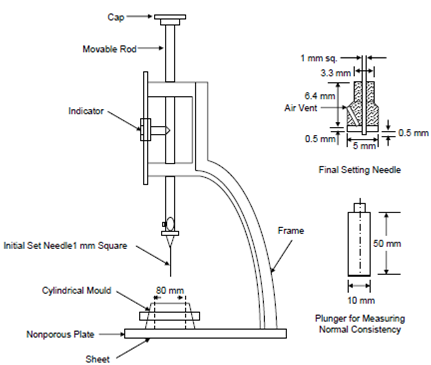Consistency Test:
The purpose of test is to determine the quantity of water required for standard consistency. For finding out setting time and soundness of cement standard consistency has to be used. Standard or general consistency of a cement paste is defined as that consistency which will permit the 'Vicat plunger' 10 mm diameter and 40 to 50 mm in length to penetrate to a point 5 to 7 mm from the bottom (or 33 to 35 mm from the top) of the Vicat mould when the cement paste is tested within 3 to 5 minutes after the cement is thoroughly mixed with water.
Vicat apparatus consists of a metal frame, movable rod with cap at the top and plunger at the bottom end and a mould. The weight of movable rod along with cap and attachment is limited up to 300 gms. It is provided with a releasing pin to make the rod free and is attached with an indicator to take readings on a vertical scale, which is graduated from 0 to 40 mm in either direction.
To perform this test take about 400 gm of cement and prepare a paste with a weighed quantity of water, say 25%. The paste obtained should be filled in the mould of the Vicat apparatus. The interval of time among the instant of adding water to the dry cement and the instant of commencement of filling the mould is called the time of gauging. A time of gauging must be among 3 to 5 minutes.
The plunger of diameter 10 mm is lowered gently on to the paste in the mould. The settlement of the plunger is noted. If the settlement is between 5 to 7 mm from the bottom of the mould (or 33 to 35 mm from the top), the amount of water added is correct and is corresponding to standard consistency of cement. If this condition is not fulfilled, the test must be repeated again changing the percentage of water until the required extent of penetration of the plunger is reached.
Let W1 = Weight of cement taken for the test, and
W2 = Weight of water added for desired penetration Percentage of water for normal consistency = P = (W2/W1) × 100. It varies from 25 % to 35 %.

Figure: Vicat Apparatus